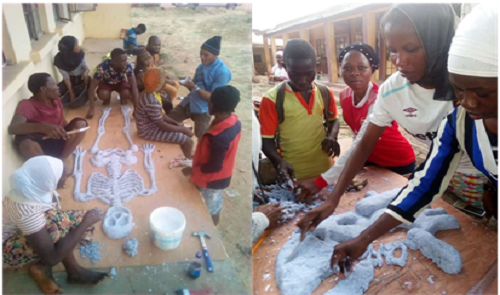
Development of Teaching – Aid Materials for Teaching and Learning Biology: A Waste to Wealth Approach (Paper Mache)
Abstract
Keywords
Full Text:
PDFReferences
Abdel-Shafy, H. I., and Mansour, M. S., (2018). “Solid waste issue: Sources, composition, disposal, recycling, and valorization,” Egyptian Journal of Petroleum.
Aghajani, M., Taherei, G. P., Sulaiman, N. M. N., Basri, N. E. A., Saheri, S., Mahmood, N. Z., Jahan, A., Begum, R. A., Aghamohammadi, N., (2016). Application of TOPSIS and VIKOR Improved Versions In A Multi Criteria Decision Analysis To Develop An Optimized Municipal Solid Waste Management Model. J. Environ. Manag. 166, 109-115.
Bahrani, S., Ebadi, T., Ehsani, H., Yousefi, H., Maknoon, R., (2016). Modeling Landfill Site Selection By Multi-Criteria Analysis Of Policy Options For Hydropower Surplus Utilization In Paraguay. Energy Policy 108, 312-321.
Bahrani, S., Ebadi, T., Ehsani, H., Yousefi, H., Maknoon, R., (2016). Modeling Landfill Site Selection By Multi-Criteria Analysis Of Policy Options For Hydropower Surplus Utilization In Paraguay. Energy Policy 108, 312-321.
Courchamp, F., Fournier, A., Ballard, C., Bertelsmeier, C., Bonnaud, E., Jeschke, J.M., Russell, J.C. (2017). Invasion Biology: Specific Problems And Possible Solutions. Trends. Ecol. Evol., 32(1), 13-22,
Damisa, D., Sule, E. I. and Moneme, S.,( 2012). “Cellulase Production From Waste Paper Using Trichoderma Species Isolated From Rhizospheric Soil”, African Journal of Biotechnology, 11(97), 1634216346.
Fercoq, A., Lamouri, S., & Carbone, V. (2016). Lean/Green Integration Focused On Waste Reduction Techniques, J. Clean. Prod.
Golden Plains Shire Council. The 7 R's of Recycling.(2016).Retrieved from: https://www.goldenplains.vic.gov.au/residents/my-home/recycling-and-rubbish/7-rs-recycling.
Hilson, G. (2002). The Environmental Impact Of Small‐Scale Gold Mining In Ghana: Identifying Problems And Possible Solutions. Geogr. J., 168(1), 57-72
Hubbe and Bowden, (2009). Handmade Paper, Review,”BioResources, 4(4): 1736-1792.
Hubbe, M. A. (2006). Bonding Between Cellulosic Fibers In The Absence And Presence Of Dry-Strength Agents – A review,”BioResources,1 (2): 281-318.
Hubbe, M. A. (2017). Paper's Resistance To Wetting - A Review Of Internal Sizing Chemicals And Their Effects, BioResources, 2(1), 106145.
Hubbe, M. A., Chen, H., and Heitmann, J. A.,(2019). “Permeability Reduction Phenomena In Packed Beds, Fiber Mats, And Wet Webs Of Paper Exposed To Flow Of Liquids And Suspensions: A Review,” BioResources, 4(1): 405-451.
Ivanova, D., Stadler, K., Steen-Olsen, K., Wood, R., Vita, G., Tukker, A., Hertwich, E.G. (2016). Environmental Impact Assessment Of Household Consumption. J. Ind. Ecol., 20(3), 526-536.
Johari, H. Alkali, H. Hashim, S. I. Ahmed, and R. Mat, (2014). Municipal Solid Waste Management And Potential Revenue From Recycling In Malaysia,” Mod. Appl. Sci.
Karademir, A., S. Karahan, S. İmamoğlu, M. Ertaş, A. Aygan, C. Aydemir, E. Peşman (2012) “Using Enzyme and Ultrasonic Energy To Recycle Paper”, Tüketim Toplumu Ve Çevre Sempozyumu, pp. 688-709.
Lenin, S. M., Jeeva, D. & Vadivel, M. 2016 “Flexural Behavior of Concrete Using Waste Paper Sludge Ash”, International Journal of Earth Sciences and Engineering, 9(3), 497-500.
Lukman, D.(2021). How improvisation of instructional materials can influence students academic Achievement. Medium,
Matsakas L., Gao, Q. Jansson, S., Rova, U., and Christakopoulos, P. (2017). Green Conversion Of Municipal Solid Wastes Into Fuels And Chemicals, Electronic Journal of Biotechnology.
Müller, L. (2014). White Magic: The Age of Paper. Polity Press. ISBN 978-0-7456-7253-3.
Navarro, R. Macro, A. Marcelo, G. Edith, V. Paolo and Vincenzo, T., (2019), How to Improve Recycling Rate In Developing Big Cities: An Integrated Approach For Assessing Municipal Solid Waste Collection And Treatment Scenarios, Environment Development, 29, 94-110.
Oriyomi M. Okeyinka, Oluwatobi J. Idowu, (2014) Assessment of the Suitability of Paper Waste as an Engineering Material”, Engineering, Technology & Applied Science Research, 4(6), 724-727.
Parry, R. (1998). Agricultural Phosphorus And Water Quality: A US Environmental Protection Agency Perspective. J. Environ. Qual., 27(2), 258-261.
Pivnenko, K., Olsson, M. E., Götze, R., Eriksson, E., & Astrup, T. F. (2016). "Quantification of chemical contaminants in the paper and board fractions of municipal solid waste" (PDF). Waste Management. 51: 43–54.
Pivnenko, K.; Pedersen, G. A.; Eriksson, E.; Astrup, T. F. ( 2015). "Bisphenol A and its structural analogues in household waste paper" (PDF). Waste Management. 44: 39–47.
Pivnenko, Kostyantyn; Laner, David; Astrup, Thomas F. (2016). "Material Cycles and Chemicals: Dynamic Material Flow Analysis of Contaminants in Paper Recycling". Environmental Science & Technology. 50 (22): 12302–12311.
Prema, M. Lakshmi Prabhaand G. Gnanavel, (2015). Production of Biofuel using Waste Papers from Pseudomonas Aeruginosa, International Journal of ChemTech Research, 8(4), 18031809.
Seik, F. T. (1997). Recycling of Domestic Waste: Early Experiences in Singapore. Habitat. Int., 21(3), 2016277-289.
Turgut, Ş.H. (2013) “A Study of What Changes Paper Recycling Operations Cause In The Structure of Cellulose”, SDÜ Orman Fakültesi Dergisi, Sayı: 14. 74-80.
Vitorino deSouzaMelare, A.,Montengro Gonzalez, S., Faceil, K., Casedei, V., (2017). Technologies and Decision Support Systems To Aid Solidwaste Management: A Systematic Review. Waste Mang. 59, 567-584
Wiedinmyer C., Yokelson R. J., Gullett B. K. (2014). Global Emission Of Trace Gases, Particulate Matter And Hazardous Air Pollutants From Open Burning Of Domestic Waste. Environ. Sci. Technol. 9523-9530.
Yakut, A. (2012) “A Study of Producing New Paper From Recyclable Used Paper”, Tesisat Mühendisliği, Sayı. 127. 68-75.
Yetim, A. (2014) “Recycling Industry In The World And In Turkey” Ar-Ge Bülten, İzmir Ticaret Odası, Haziran, 11-16.
Yurtman, A. & Aydin, C. (2001) “Waste Paper Recycling And Opportunities”, İstanbul Ticaret Odası Yayını, İstanbul.
Zarewa H. O.(2005). Towards the Successful U.B.E Implementation Through The Use Of Locally Sourced Materials In The Teaching Of Basic, Concepts In Integrated Sciences. Africa Journal of Materials and Natural Resources, federal college of education Kano, 1(l). l53.
DOI: http://dx.doi.org/10.31258/jes.7.4.p.545-560
Refbacks
- There are currently no refbacks.
Copyright (c) 2023 Bello Zakariyau Adebayo

This work is licensed under a Creative Commons Attribution 4.0 International License.
Publisher: FKIP Universitas Riau












